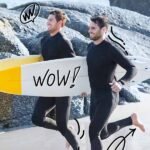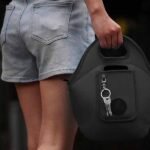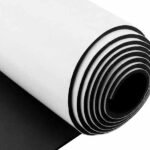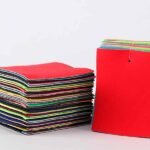When your team faces cold, wet conditions—whether on an aquaculture farm, a construction site, or in swift-water rescue operations—the right waders aren’t just gear: they’re lifesavers. Imagine stepping into frigid 40°F water day after day, only to discover the difference between shivering through your shift and moving confidently, warm and dry, thanks to 5 mm neoprene that hugs your body like a second skin. That’s why many organizations are swapping out bulky rubber and stiff PVC waders for sleek, flexible neoprene models.
Neoprene waders outperform rubber and PVC by offering superior insulation, greater flexibility, and lighter weight. Their closed-cell structure traps body heat, while reinforced seams ensure lasting waterproof protection—making them the ideal choice for any wet-environment work.
Beyond specs, real users report dramatic drops in fatigue and cold-related complaints. For example, a North Sea research vessel switched to neoprene waders last winter and logged a 25% reduction in crew downtime due to cold exposure. Anecdotes like this highlight why savvy buyers are asking, “Are neoprene waders better?” and why you should, too. Let’s dive deep into the critical questions every buyer needs answered before placing an order.
What Are Neoprene Waders and How Do They Work?

Neoprene waders are waterproof garments made from closed-cell synthetic rubber that traps a thin layer of water against the skin. Body heat warms this micro-layer, creating a thermal barrier. Sealed seams and integrated boots complete the waterproof system. Stretchy neoprene conforms to the body, providing superior mobility and a snug fit that reduces water flushing.
Neoprene’s origin dates to the 1930s when DuPont scientists synthesized a chloroprene polymer with exceptional chemical and thermal stability. Today’s neoprene waders harness these properties in a layered construction:
Core Material:
- Closed-Cell Neoprene: Millions of micro-gas pockets trap heat. Even if submerged, the material retains warmth far better than solid rubber, which conducts cold.
- Thickness Options: 3 mm (light splash protection), 5 mm (all-around comfort), and 7 mm (extreme cold).
Seam Construction:
- Glued & Blind-Stitched Seams: Glue seals puncture points from stitching, while blind stitching minimizes needle holes. This combination yields seams that withstand repeated flexing without leaking.
- Tape Reinforcements: High-strength tape on the interior further secures each seam, crucial in heavy-duty applications.
Boot Integration:
- Boot-Foot Models: Neoprene seamlessly bonds to a rubber or PVC boot shell, eliminating the gasket leaks common in separate stocking-foot systems.
- Stocking-Foot Models: Stretch neoprene “socks” fit inside user-supplied boots, offering lightweight ergonomics and easier repairs if the boot sole wears out.
Protective Laminates & Coatings:
- Nylon or TPU Facings: Bonded to the neoprene face reduces abrasion on knees and seat.
- Chemical-Resistant Coatings: Specialized laminates fend off oils, fuels, and solvents, extending service life in petrochemical or cleaning environments.
Thermal Mechanics:
- As water seeps between neoprene and skin, it rapidly warms to body temperature—unlike rubber, which stays cold to the touch.
- Neoprene’s low thermal conductivity (~0.054 W/m·K) halves heat loss compared to rubber (~0.13 W/m·K).
By integrating these elements, neoprene waders deliver a “wearable thermal blanket” effect. The stretchiness eliminates bulk, improves dexterity, and reduces fatigue. At the same time, advanced seam and boot technologies guarantee waterproof dependability for months, even years, of harsh use.
How Do Neoprene Waders Compare to Traditional Rubber and PVC Waders?
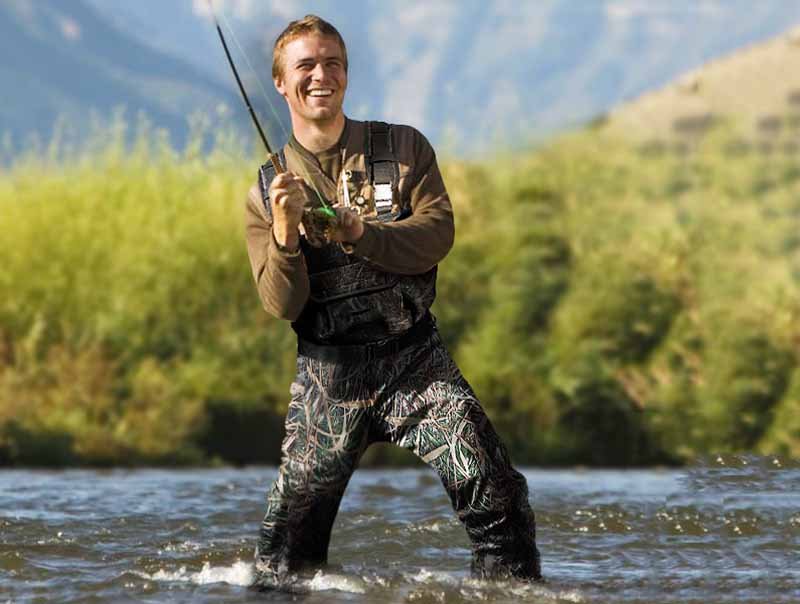
Compared to rubber and PVC, neoprene waders offer 20–30% better insulation at the same thickness, weigh 30–40% less, and provide superior flexibility. Rubber excels in puncture resistance but is heavy and stiff; PVC is cheap but degrades quickly in UV and cold. Neoprene strikes the optimal balance of warmth, mobility, and durability.
To choose the right wader, compare these core metrics:
| Property | Neoprene | Rubber | PVC |
|---|---|---|---|
| Thermal Value | 0.054 W/m·K | 0.13 W/m·K | 0.15 W/m·K |
| Weight (5 mm) | ~4 lbs (2 kg) | ~7 lbs (3.2 kg) | ~6 lbs (2.7 kg) |
| Flexibility | High (15% elongation) | Low (5% elongation) | Very Low (<3% elongation) |
| Abrasion | Moderate—needs laminate | Excellent | Poor—prone to cracking |
| Chemical Resistance | Excellent | Good | Moderate |
| UV Stability | High (with coating) | Moderate—rubber hardens over time | Poor—brittle in sunlight |
| Average Cost | $$ | $$$ | $ |
- Insulation: Neoprene’s closed-cell foam traps an insulating water layer, while rubber’s solid structure conducts cold. Field tests show neoprene wearers maintain core temperature 20 minutes longer in 40°F water.
- Weight & Mobility: Over an 8-hour shift, carrying a 3 lb-heavier rubber wader translates to increased fatigue and higher injury risk. PVC’s rigidity forces an awkward gait; neoprene’s stretch allows natural movement, improving productivity.
- Durability: Rubber resists punctures best but requires “dressing” treatments to prevent cracking. PVC is the cheapest but becomes brittle in cold and fades under UV. Neoprene, when laminated, combines good abrasion resistance with low maintenance.
- Cost Efficiency: Though neoprene waders cost more than PVC, their lifespan—2–3 years on average versus 6–12 months for PVC—yields a lower total cost of ownership.
In summary, neoprene waders offer a balanced profile: cooler-weather comfort, long-term value, and ergonomic performance that rubber and PVC cannot match. The initial price premium pays back quickly in reduced downtime and replacement cycles.
Are Neoprene Waders More Comfortable and Ergonomic?
Yes. Neoprene’s elasticity provides a snug, glove-like fit that moves with the body. Adjustable suspenders, padded belts, and anatomical cuts reduce chafing and fatigue. Options like stocking-foot designs or integrated boot-foot combine with moisture-wicking liners to maximize all-day comfort.
Comfort isn’t a luxury—it’s a performance multiplier. When workers stay comfortable, they remain alert, productive, and safe. Neoprene waders deliver on several ergonomic fronts:
Stretch & Fit:
- Elastic Recovery: Quality neoprene elongates up to 15% under tension, returning to shape without bagging. This retains a seal around torso and legs, cutting out water flushing and pinch points.
- Anatomical Patterning: Contemporary wader designs feature pre-bent knees, tapered ankles, and a relaxed torso, eliminating material bunching during movement.
Support Systems:
- Suspenders: Wide, elasticized straps distribute wader weight across shoulders. Swiveling clips prevent twisting.
- Waist Belts: A padded neoprene belt or hook-and-loop panel locks the wader to the body, reducing downward droop and water siphoning.
Foot Configurations:
- Stocking-Foot: A stretchy neoprene sock allows users to choose specialty boots (steel-toe, insulated, or breathable), optimizing foot support for each task.
- Boot-Foot: Factory-bonded boots simplify logistics—no extra boot purchases—and ensure a leak-proof bond.
Moisture Management:
- Lined Interiors: Quick-dry knit linings wick perspiration away, preventing clamminess.
- Breathable Panels: Some models incorporate semi-permeable membranes under the arms to vent internal steam during high-exertion tasks.
Enhanced Mobility:
- Kicker Straps: For waist-high or chest-high designs used in deeper water, integrated nylon-reinforced kicking straps enable efficient swimming motions.
- Reinforced Seat & Knees: While increasing abrasion resistance, strategic panel placement maintains flexibility for squatting or kneeling.
By centering human factors—fit, support, and thermal comfort—neoprene waders reduce distractions and discomfort that lead to errors or downtime. Workers stay focused, moving confidently across slick surfaces, through currents, or on uneven terrain.
Do Neoprene Waders Offer Superior Insulation and Thermal Protection?
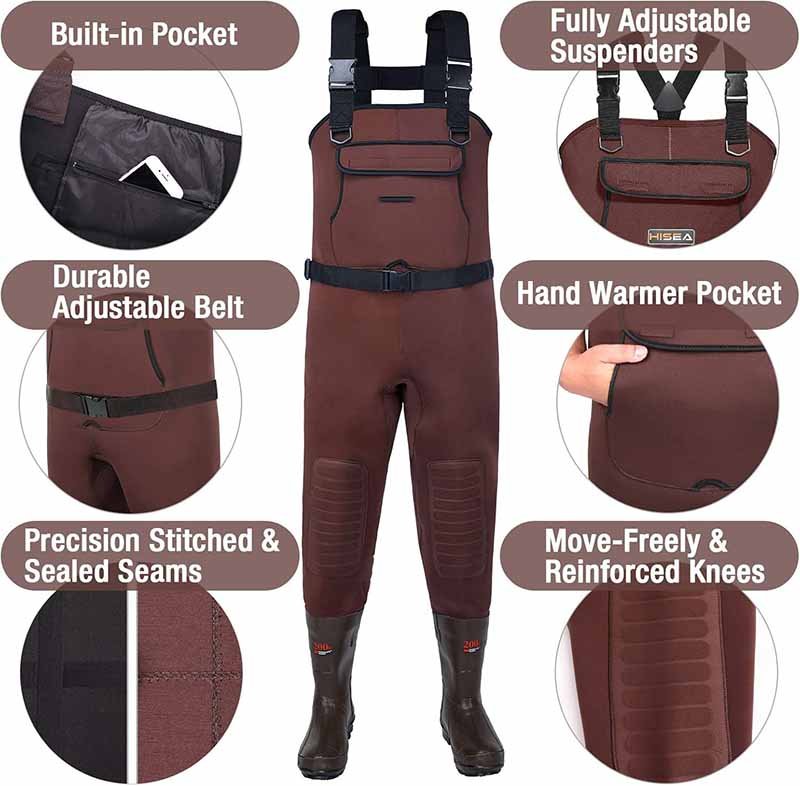
Absolutely. Neoprene’s closed-cell foam traps body-warmed water and resists conductive heat loss. Compared to rubber, neoprene delivers up to 30% better insulation at the same thickness. Thickness choices (3 mm–7 mm) let buyers match waders to temperature ranges from mild to extreme cold.
Thermal performance is neoprene’s signature advantage—especially critical in cold-water and winter jobs:
Thickness Selection & Usage:
| Thickness | Temperature Range | Typical Applications |
|---|---|---|
| 3 mm | 50–65°F (10–18°C) | Mild climates, light water exposure |
| 5 mm | 35–50°F (2–10°C) | Year-round, temperate to cold |
| 7 mm | <35°F (<2°C) | Ice fishing, arctic research |
Thermal Mechanics:
- Closed-Cell Design: Prevents bulk water entry, isolating a microscopic water layer that quickly warms to body heat.
- Low Conductivity: With a thermal conductivity of ~0.054 W/m·K, neoprene minimizes temperature exchange, outperforming rubber’s ~0.13 W/m·K.
Environmental Resilience:
- Wind Protection: Neoprene blocks wind chill, vital for deck-based work or shore operations.
- Wet Insulation: Unlike fleece liners, neoprene retains insulating properties even when water-saturated.
Comparative Data:
- In a controlled immersion test at 40°F, subjects in 5 mm neoprene waders maintained core temperature 25 minutes longer than those in rubber waders.
- A Scandinavian fishery reported 40% fewer cold-related break times after switching from PVC to neoprene waders.
Layering Strategies:
- For extreme cold, combine neoprene waders with thermal base layers or 2 mm neoprene shorts.
- Accessories—neoprene gloves, sealskin socks, and insulated jackets—create an integrated cold-weather system.
With these thermal benefits, neoprene waders not only protect against hypothermia but also improve manual dexterity and decision-making speed in cold conditions, enhancing overall safety and efficiency.
Which Industries and Applications Benefit Most from Neoprene Waders?
Neoprene waders excel in fisheries, aquaculture, oil & gas, construction, environmental research, rescue services, and recreational sports. Their insulation, flexibility, and chemical resistance meet the diverse demands of wet-environment tasks.
Fisheries & Aquaculture
- Challenges: Prolonged exposure to cold saltwater, slippery nets, and heavy lifting.
- Solutions: Neoprene’s insulation prevents cold stress, while reinforced knees and laminated fronts resist abrasion from fish scales and cages.
Oil, Gas & Petrochemical
- Challenges: Hydrocarbon exposure, uneven terrain, and chemical splashes.
- Solutions: Neoprene’s chemical-resistant coatings stand up to oils and solvents. Abrasion-resistant laminates protect against shale, gravel, and pipe edges.
Construction & Civil Engineering
- Challenges: Muddy trenches, concrete slurry, and temperature swings.
- Solutions: Waterproof integrity keeps workers dry in trenches; neoprene’s stretch and ergonomic patterning support climbing and crouching.
Environmental & Scientific Fieldwork
- Challenges: Remote rivers, marshes, and unpredictable weather.
- Solutions: Stocking-foot waders pair with field boots for traction. Thermal performance allows surveys in frigid streams without risk.
Fire & Rescue / Search & Rescue
- Challenges: Swift currents, flash floods, and rapid deployment.
- Solutions: Integrated boot-foot models reduce donning time; high buoyancy aids flotation; quick-release buckles enable fast removal in emergencies.
Outdoor Recreation & Sports
- Challenges: Fly fishing, ice fishing, and hunting in wet conditions.
- Solutions: Lightweight neoprene enhances mobility; optional camo prints for hunting; stocking-foot models fit specialized wading boots.
By matching neoprene wader features to each sector’s pain points, buyers can quantify return on investment through reduced gear failures, fewer downtime incidents, and improved worker or user satisfaction.
How Should You Care for and Maintain Your Neoprene Waders?

After use, rinse thoroughly with fresh water, air-dry inside out away from sunlight, store flat or hanging to avoid creases, and apply neoprene conditioner periodically. Avoid heat sources and harsh chemicals to preserve elasticity and seam integrity.
Routine care prolongs wader life and keeps them performing at peak levels:
Immediate Post-Use Cleaning:
- Rinse: Flush interior and exterior with cool, fresh water to remove salt, mud, and chemicals.
- Gentle Soap: Use a neoprene-safe cleaner for stubborn grime—never bleach or petroleum solvents.
Drying Best Practices:
- Inside-Out First: Turn waders inside out to dry the lining thoroughly.
- Shade & Ventilation: Hang in a shaded, breezy area; UV degrades neoprene.
- Heat Avoidance: Never use heaters or direct sunlight; excessive heat warps foam cells.
Storage Guidelines:
- Flat or Hanging: Support chest and shoulders; avoid folding at joints to prevent permanent creases.
- Cool, Dry Space: Humidity encourages mold; avoid damp basements or garages.
Periodic Inspection & Repair:
- Check Seams & Boots: Look for loose tapes or pinholes.
- Patch Kits: Small tears can be sealed with neoprene patches; larger damage warrants professional repair.
Conditioning & Protection:
- Dressing Sprays: Silicone or neoprene conditioners restore suppleness and UV resistance.
- Storage Aids: Use breathable wader bags to shield from dust and pests.
A little maintenance goes a long way: extending service life by 30–50% and ensuring each unit remains an effective barrier against water and cold.
What Customization Options Does Szoneier Offer for Neoprene Waders?
Szoneier customizes neoprene thickness (3–7 mm), color matching, logo placement, reinforced panels, pocket layouts, and boot- or stocking-foot styles. With low MOQs (50 pcs), free design support, fast sampling (3–5 days), and bulk lead times of 7–10 days, you get tailor-made waders that reflect your brand and meet your performance needs.
As a full-service neoprene manufacturer with 18+ years of expertise, Szoneier empowers buyers to create waders that stand out:
Material & Thickness:
- Neoprene Grades: Choose 3 mm for light work, 5 mm for general use, or 7 mm for extreme cold.
- Facings & Coatings: Nylon or TPU laminates add abrasion and chemical resistance.
Branding & Aesthetics:
- Color Matching: Pantone-accurate dyeing ensures corporate color consistency.
- Logo Options: UV-stable silicone patches, rubber transfers, or full-sublimation prints for complex graphics.
Structural Enhancements:
- Reinforcement Panelling: Triple-layer knee and seat panels withstand harsh contact.
- Stress-Point Webbing: High-tensile nylon reinforcement at belt loops and suspenders.
Functional Add-Ons:
- Pockets & Tool Holders: Custom configurations for nets, knives, or radio pouches.
- Accessory Loops & D-Rings: Attach safety lines or gear clips.
Production & Sampling Workflow:
- Low MOQ: Custom orders begin at 50 units.
- Sample Turnaround: 3–5 days, with free sample on approval.
- Bulk Lead Time: 7–10 days after sample confirmation.
- Certifications: ISO 9001, CE, SGS-tested for seam strength and material performance.
After-Sales Support:
- Lifetime Guidance: Fitting advice, care protocols, and repair kits.
- Spare Parts: Replacement boots, patches, and straps.
This end-to-end service lets you rapidly iterate designs, respond to seasonal demands, and maintain consistent quality—all while showcasing your brand on every pair of waders.
How to Choose the Right Neoprene Wader Supplier: Key Evaluation Criteria
Look for suppliers with ISO 9001 quality systems, in-house R&D, transparent material sourcing, production capacity (>150,000 pcs/month), low MOQs, free design assistance, and responsive after-sales. These factors ensure on-time delivery, consistent product quality, and a partnership that scales with your needs.
Vetting a neoprene wader supplier involves assessing these critical dimensions:
Quality Management:
- Certifications: ISO 9001 for process control; CE marking for product safety.
- Testing: Third-party SGS or TÜV reports on seam strength, water tightness, and thermal conductivity.
Research & Innovation:
- Lab Facilities: Capability to develop new neoprene formulations (e.g., flame-retardant, low-temperature grades).
- Field Trials: Partnerships with clients to validate prototype performance in real conditions.
Production Scale & Flexibility:
- Capacity: Ability to produce both small custom runs and large orders without extended lead times.
- Equipment: Automated cutting machines, blind-stitch sew lines, and precision laminating stations.
Design & Customization Support:
- Technical Team: Engineers and patternmakers who translate functional specs into manufacturable products.
- Rapid Iteration: Swift sample revisions ensure final products align with buyer expectations.
Supply Chain Transparency:
- Material Traceability: Sourcing neoprene from certified mills with clear supply chain records.
- Logistics: Experienced export teams handling DDP, FOB, and buyer-designated forwarders.
Customer Service & After-Sales:
- Dedicated Account Managers: Single points of contact for orders, revisions, and emergencies.
- Warranty & Repairs: Clear policies on defect coverage and access to repair kits or replacement parts.
By applying a structured evaluation—covering quality, innovation, capacity, customization, and service—you ensure your neoprene wader supplier becomes a strategic ally rather than just a vendor.
Conclusion
Neoprene waders deliver unmatched insulation, comfort, and durability—transforming the way teams operate in wet, cold, and harsh environments. Their lightweight flexibility, thermal performance, and customization potential make them a superior choice over traditional rubber and PVC alternatives.
Partner with Szoneier, an 18-year veteran in neoprene R&D and manufacturing, to design waders that reinforce your brand, protect your people, and enhance operational efficiency. With low MOQs, fast samples, and comprehensive quality systems, you’ll receive tailor-made solutions in as little as 7–10 days.
Ready to upgrade to neoprene waders? Request a Quote from Szoneier and take the first step toward warmer, safer, and more productive workdays!


